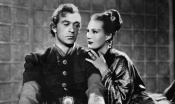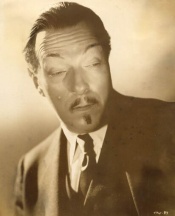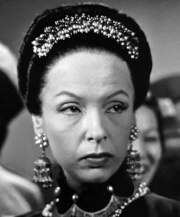Chapter 26
How to Format Entries
Quoted Text
Explanation or analysis of Quoted Text
- Individual opinions or discussion. Sign by writing "~~~", if you like.
To add a page: Type ==Page xx==
Please add entries for each page in the order they appear on the page.
Contents
Page 275
formaldehyde
Clothing is coated with formaldehyde to make them "wrinkle free". Formaldehyde is also used to preserve corpses. Most people are familiar with the miasma from frog dissection in high school biology.
The Thug, here rendered in fuchsia and optical green
That is, looking a lot like the Hulk.
Page 276
a mural-size screen grab from the opening of The Letter (1940) in which Bette Davis is pretending to pump six rounds into...
Image and film info at allmovie. Bette comes out with gun blazing at 1:18 into this clip.
David Newell
Supporting actor turned makeup artist. IMDB makes it appear he spent much of his career being uncredited for his work.
Page 277
It's what, legal in Utah for three people to get married?
Despite being illegal, in Utah today, those living in polygamist families number about 40,000 people(about 1.4 percent of the population). Polygamists are difficult to prosecute because many only seek marriage licenses for their first marriage, while the other marriages are secretly conducted in private ceremonies. Thereafter, secondary wives attempt to be seen in public as single women with children.
Page 278
Dr. Brown's Cel-Ray
Dr. Brown's is a brand of soft drink made by J&R Bottling. It is a popular brand in the New York City region and in South Florida, but it can also be found in Jewish delicatessens and upscale supermarkets around the United States. Dr. Brown's dates back to 1869 when their famous Dr. Brown's Cel-Ray soda was commonly sold in New York delicatessens. [1]
a bit on the demi-sec side
"Demi sec" is a French term for the sweetness of a wine. It translates to "semi-dry" or medium-dry. [2]
folie à deux
French: "madness for two" — a shared psychotic disorder between two people who are extremely close
Page 279
Far from the Channel 13 upper-class dynasty
Channel 13 is a New York City PBS station, PBS being the preferred network for the educated and well healed.
well east of the Nassau line
That is, not in Nassau County which is the 13th wealthiest county in the US with a median income of $93K+. [3]
The Muffya
A bad pun on The Mafia... "Muff" is slang for pussy etc.
Donna non vidi mai
Italian: "I have never seen a woman" - So Rocky is watching Cornelia shower while he eats a pizza and sings this tenor aria from Act 1 of Puccini's Manon Lescaut. A love-at-first-sight soliloquy. "I have never seen a woman like this!" Pynchon referenced the Act 3 tenor solo in Chapter 3 of V.
Down in K-Town they call him '4-D'
Koreatown is an ethnic Korean enclave in Midtown Manhattan in New York City, centered on the block of West 32nd Street between Fifth and Sixth Avenues. [4]
Page 280
the high-muzzle-velocity law firm of Hanover, Fisk
Nice little pun on "hand over fist", as in making money hand over fist... Muzzle velocity is the speed a projectile has at the moment it leaves the muzzle of the gun. So “high” would be very fast! So it’s used metaphorically to describe the law firm, that they’re high powered, handling big cases. This rifle reference connects to the reference to the Mannlicher-Carcano rifle on page 282, the high-muzzle-velocity rifle used by Lee Harvey Oswald to assassinate President Kennedy in 1963.
New Zealand kauri
WIKI tells us kauri forests are some of the oldest in the world, that individual trees often live longer than 600 years, and that they are very large trees with volumes, but not heights, often rivaling sequoias.
Page 281
Skadden, Arps
A real law firm in Washington, DC.
Page 282
Mannlicher-Carcano . . . Jackie and I were dear friends
A Mannlicher-Carcano is a high-muzzle-velocity rifle and what Lee Harvey Oswald used to assassinate John F. Kennedy in 1963. Jackie was, as most are aware, JFK's wife and the first lady.
"Jay-Z?" "Well, actually I'm more of a Nas person. As you may know they're in this feud at the moment, that old Queens-versus-Brooklyn thing again, hate to take sides, but---"The World Is Yours," how can anything even compare?
Probably splitting hairs here, but the feud between Jay-Z and Nas didn't become widely known until Jay-Z's "Takeover" was released on his "Blueprint" album, which came out on September 11. Jay-Z did dis some rappers at the Hot 97 Summer Jam 2001 held in late June, but the hardest hit was Nas' friend and Queens resident Prodigy of Mobb Deep, while Nas was only briefly mentioned. You'd probably had to have been close to the inner circles of these rappers to be conversationally aware of the feud which became heated in the months to come. As for "The World is Yours," reference, I agree with the sentiment, and wonder if it was used since Jay-Z sampled it on "Dead Presidents II" from his 1996 debut album. Anyone else have thoughts on this? H2oetry (talk)h2oetry
Also, it was pretty much universally accepted that Nas won the beef with "Ether," on Stillmatic which would be released in December 2001. Nas's Illmatic, from 1994, is by many, considered the greatest rap record of all time, and extremely rare these days, only contains one guest appearance for a single verse (AZ on "Life's a Bitch"). The above question in regard to the use of "The World is Yours," is indeed possible, though most likely it's used here because the phrase references Scarface, which kind of ties into the theme of this part of the book, I'd say.
Tryin to do Tupac and Biggie thangs ... Mort and Pell—
A brilliant rap about the racism against Asians implicit in Caucasians playing Asians in 1930s-40s Hollywood films, and asssociated stereotypes. Darren sets out to do what Tupac and Biggie did, i.e., promoting his own cultural values and decrying societal injustices via the rap idiom.
The set up is when Chandler Platt's intern Darren who we assume is Asian when Maxine wants to avoid using "inscrutably" to describe his expression, "inscrutable" being a stereotypical characteristic of Asians. Thus, the trope of Asian stereotypes is introduced, and leads to Darren kicking off his rap with "Dig it..."
Tryin to do Tupac and Biggie thangs
Like Tupac (aka 2Pac) Shakur and Notorious B.I.G. (aka Biggie Smalls), two very successful rappers in the 1990s, Darren wants to be a rap warrior for his people, his culture.
Nice rhyme: Biggie thangs / piggy banks ... Darren wants to be a Big Rap Star, but he wants to do it the Asian way. Perhaps using Chairman Mao here is Darren's way of using a homegrown and authentic Asian icon to represent his way. Interesting that it's a Chairman Mao piggy bank, Mao being iconic of Marxism, as opposed to the blatantly capitalist pursuit of fame and money by American rappers. Down the page a bit, when asked by Platt how he expects to make money, Darren replies that making money is "not the point."
Page 283
like Screamin Jay in Hong Kong / jumpin to wrong conclusions
Screamin' Jay Hawkins recorded "Hong Kong" (1958), a paranoid & non-sensical lament ("Standin' on a corner in Hong Kong / My baby was down in Hong Kong / Worried about you baby / You been down too long / in Hong Kong") . I assume it's Screamin' Jay who's "jumpin to wrong conclusions" about his baby and about how scary Hong Kong is. His hysterical delivery, paranoia about his baby's fate, and his fake-Chinese babbling indicate a frightened Western man in an Eastern land with a strong whiff of racism. A wacky tune, for sure:
old-movie confusions
The "old-movie confusions" are confusion about both the general characterization and stereotyping of Asia and Asians in the 1930s-era Hollywood films, and about Caucasian actors playing Asian characters (aka Yellowface [5]), such as in the four American films referenced in Darren's rap — "The Adventures of Marco Polo" (1938) [6] where both Kubla Khan and his daughter Princess Kukachin are played by Caucasian actors; The "Charlie Chan" films [7] in which Warner Oland played detective Charlie Chan for 15 of the films, until his death in 1938; "The Letter" (1940) [8] where Gale Sondegaard, an American actress born to Danish-American parents, plays the role of Mrs. Hammond, the asian wife of Davis's manservant whom she murders; and "The Bitter Tea of General Yen" (1933) [9] where all the Asian characters are played by Caucasians. (Yes, Pynchon spells it "General Yan" — but this covers both an anime character (General Yan) and the 1933 film (General Yen), or perhaps it's just a typo.)
yo, who be dat Scandinavian brand of Azian
Why, it's Sigrid Gurie, of course, who played Kubla Khan's daughter in "The Adventures of Marco Polo"! Spelling "Asian" as "Azian" derives from early Internet chatting where "Asian" was abbreviated "AZN".
In "The Adventures of Marco Polo," the character of Kublai Khan (spelled "Kubla" in the film credits) is played by George Barbier, and Khan's daughter Princess Kukachin is played by Norwegian-American actress Sigrid Gurie. Most of the other Chinese characters in the film are played by Caucasians. Kublai Khan was the ruler of the Mongol Empire from 1260 to 1294, and the founder of the Yuan Dynasty. Marco Polo was the first European to visit China and publish a detailed chronicle of his experience. [10]
Here's a clip from the film. Note Sigrid Gutrie as Princess Kukachin, seated to the right of her father Kubla Khan:
Warner Oland (1879-1938) was a Swedish American actor who played the detective Charlie Chan in the popular film franchise of the 1930s. Yet another Caucasian playing an Asian and reinforcing stereotypes. Oland also played another Asian, Fu Manchu, in the first three films of that franchise. [11]
General Yan / bitter tea
As mentioned above, likely a double reference: 1) General Yan, the former Commander-in-Chief of the GHQ in the Guilty Crown anime franchise, and 2) "The Bitter Tea of General Yen," a 1933 dramatic film directed by Frank Capra where most of the Asian actors are played by Caucasians.
Here's a fan-made trailer:
Reference to "The Letter" [12], an American noir film directed by William Wyler, where Bette Davis in the role of Leslie Crosbie is the social superior to Gale Sondegaard's Mrs. Hammond who is the wife of Davis's manservant and lover whom Davis murders. As for "pullin rank," Bette Davis was not only Sondegaard's social superior in the film, she was also the lead actress and Sondegaard the supporting actress. In "The Letter" Davis's character is stabbed (shanked - prison-yard slang) by Sondegaard's character.
Here's the trailer for "The Letter":
like they was on the yard / or down in some forgotten cell
A prison yard, of course.
far, far from the corner of / Mott and Pell—
The heart of New York City's Chinatown. [13] Indeed they are very far away as "The Letter" takes place in Malaya.
And get Hugh Goldman for me over there?" "Mad cool, yo"
Sadly, after Darren's performance, Platt comes in and himself begins "pullin rank" on Darren, brusquely cutting him off and ordering him about, to which Darren hiply but subserviently replies, "Mad cool, yo" and scoots off to do Platt's bidding.
Darren is aware of the inequities of power, of capitalism, rails against it, but remains, at least at this point, a slave beholden to his corporate master. This is reminiscent of Bryon the Bulb in Gravity's Rainbow; at page 654-655 in the original Viking edition, who ended up knowing The Truth but unable to effect any change:
- Someday he will know everything, and still be as impotent as before. His youthful dreams of organizing all the bulbs in the world seem impossible now—the Grid is wide open, all messages can be overheard, and there are more than enough traitors out on the line. Prophets traditionally don’t last long—they are either killed outright, or given an accident serious enough to make them stop and think, and most often they do pull back. But on Byron has been visited an even better fate. He is condemned to go on forever, knowing the truth and powerless to change anything. No longer will he seek to get off the wheel. His anger and frustration will grow without limit, and he will find himself, poor perverse bulb, enjoying it . . . .
And on page 713, Roger Mexico reflects on the Counterforce as the Corporate Masters' "doomed pet freaks," and wonders "which is worse: living on as Their pet, or death?"
Thus Darren's "red velvet Chairman Mao piggy bank" will be his cute but feckless weapon to fight injustice.
Gongsta Rap
AKA the Asian version of Gangsta Rap. Another cute Pynchon Pun...
They gonna be give me all rice-nigga remarks and shit, this way I beat 'em to it.
"Rice nigga" is, as you might suspect, a derogatory/racist term for Asians. Darren anticipates these kinds of remarks when he starts performing out, so he writes this rap that lampoons American stereotypes of Asians, starting with Screamin' Jay Hawkins' paranoid song "Hong Kong."
Page 284
chomping into it and scattering crumbs... Grabbing another, two or three actually
Chandler Platt has become the Cookie Monster.
Page 285
as Larry Talbot into the Wolf Man
Larry Talbot, played by Lon Chaney, Jr., was the main character of the horror film The Wolf Man (1941) [14].
- Trivia alert: Chaney played Larry Talbot in The Wolf Man. Though Chaney was in a fair number of monster movies, he was never, contrary to what Warren Zevon may have led us to believe, in a film titled "The Werewolves of London." The 1935 film Werewolf of London starred Henry Hull.
Page 286
flaneur
Term for a certain type of character found in literature, especially the works of 19th century France. WIKI tells us "Drawing on Fournel, and on his analysis of the poetry of Baudelaire, Walter Benjamin described the flâneur as the essential figure of the modern urban spectator, an amateur detective and investigator of the city. More than this, his flâneur was a sign of the alienation of the city and of capitalism. For Benjamin, the flâneur met his demise with the triumph of consumer capitalism."
| Chapter 1 pp. 1-7 |
Chapter 2 pp. 8-19 |
Chapter 3 pp. 20-29 |
Chapter 4 pp. 30-40 |
Chapter 5 pp. 41-52 |
| Chapter 6 pp. 53-67 |
Chapter 7 pp. 68-79 |
Chapter 8 pp. 80-86 |
Chapter 9 pp. 87-95 |
Chapter 10 pp. 96-111 |
| Chapter 11 pp. 112-120 |
Chapter 12 pp. 121-133 |
Chapter 13 pp. 134-144 |
Chapter 14 pp. 145-159 |
Chapter 15 pp. 160-171 |
| Chapter 16 pp. 172-184 |
Chapter 17 pp. 185-197 |
Chapter 18 pp. 198-210 |
Chapter 19 pp. 211-218 |
Chapter 20 pp. 219-229 |
| Chapter 21 pp. 230-238 |
Chapter 22 pp. 239-246 |
Chapter 23 pp. 247-255 |
Chapter 24 pp. 256-264 |
Chapter 25 pp. 265-273 |
| Chapter 26 pp. 274-287 |
Chapter 27 pp. 288-300 |
Chapter 28 pp. 301-313 |
Chapter 29 pp. 314-326 |
Chapter 30 pp. 327-337 |
| Chapter 31 pp. 338-346 |
Chapter 32 pp. 347-353 |
Chapter 33 pp. 354-364 |
Chapter 34 pp. 365-382 |
Chapter 35 pp. 383-394 |
| Chapter 36 pp. 395-407 |
Chapter 37 pp. 408-422 |
Chapter 38 pp. 423-438 |
Chapter 39 pp. 439-447 |
Chapter 40 pp. 448-462 |
| Chapter 41 pp. 463-477 |



